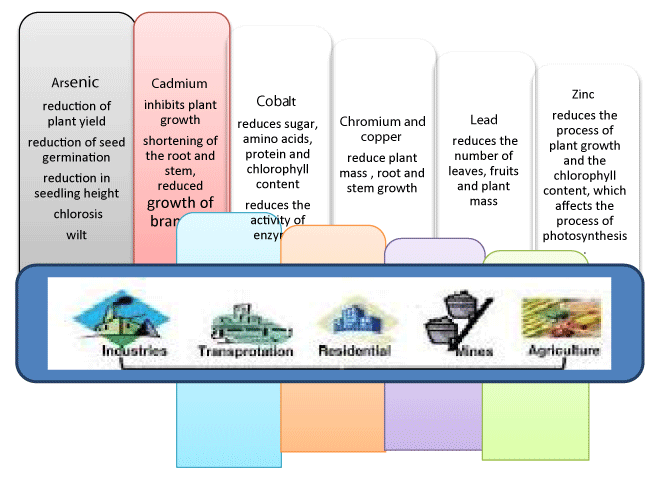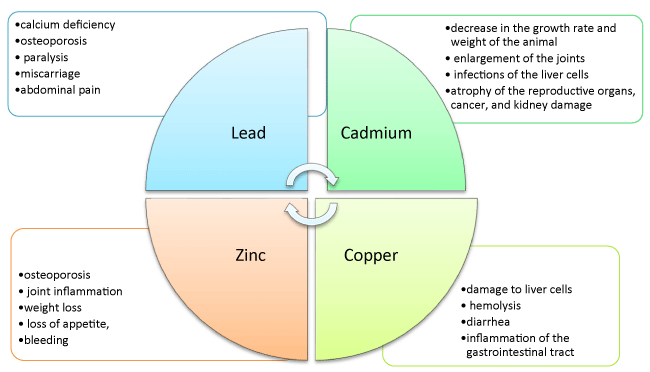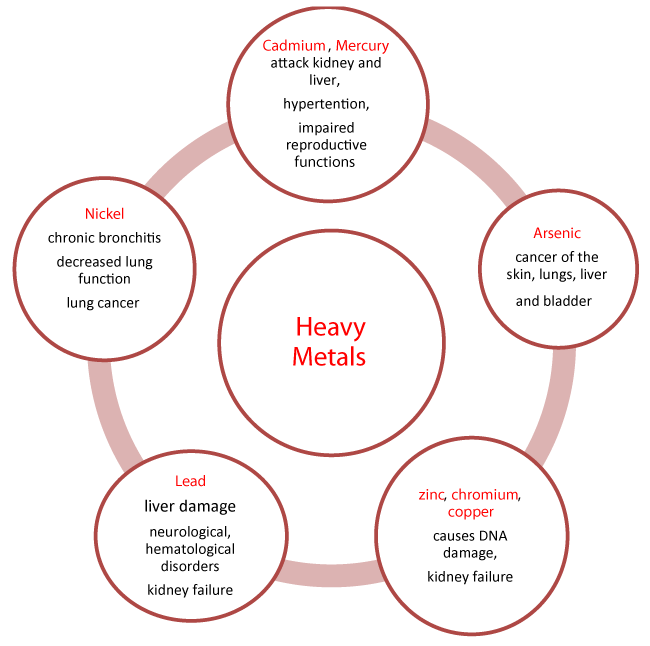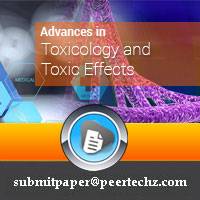Advances in Toxicology and Toxic Effects
Biological implications of atmospheric and pedospheric levels of heavy metals
Abolanle A A Kayode1*, Muhammad Akram2, Umme Laila2, Omar Ali Al-Khashman3, Omowumi T. Kayode4 and Walaa Fikry Mohammed Elbossaty5
2Department of Eastern Medicine, Government College University Faisalabad, Pakistan
3Department of Environmental Engineering, College of Engineering, Al-Hussein Bin Talal University, P.O.Box 20 Ma’an, Jordan
4Biochemistry Unit, Department of Biological Sciences, Mountain Top University, Ogun State, Nigeria
5Department of Chemistry, Damietta University, Egypt
Cite this as
Kayode A. A. A, Akram M, Laila U, Al-Khashman OA, Kayode OT, et al. (2021) Biological implications of atmospheric and pedospheric levels of heavy metals. Adv Toxicol Toxic Effects 5(1): 001-004. DOI: 10.17352/atte.000010Heavy metals and pollutants are gaining more and more attention nowadays. Heavy metals at high concentrations have an undesirable effect on soil, plants, animals, and humans. The high concentrations of these minerals reduce the activity of microbiological organisms, which affect the quality of the soil and is reflected in the inhibition of the physiological activity of plants. If plants absorb these minerals, they affect the food chain and thus reflect on plants and animals. Heavy metals have an effect on water bodies and marine organisms, as water pollution with these minerals leads to an increase in the production of reactive oxygen species that cause harm to fish and marine organisms. Therefore, it is necessary to use fertilizers that are free of those heavy metals in order to get rid of the harmful effects of heavy metals.
Introduction
One of the most important causes of soil and air pollution is human industrial activity, as some heavy metals are produced from it. Irregularities in the discharge/emissions from iron and steel factories, batteries, paints, and ceramics into the water, these do not only contribute to water pollution, but negatively affect soil and living organisms, as the accumulation of chromium, lead, and mercury leads to biological changes in terms of changing the chemical composition of proteins and amino acids which affect living organisms [1]. Plants are also affected greatly by these minerals, as they absorb them, leading to their accumulation, which leads to weak oxidative stress, cell clumping and death. Research seeks to raise the rate of plant resistance to these minerals by reducing their absorption, which improves plant productivity and crop quality [2].
Heavy metals are known as non-biodegradable pollutants that have a negative impact not only on the surrounding environment, but also on the health of humans and animals. It effectively affects some vital organs and biological processes, and the most important of these are the digestive and respiratory systems. The toxicity of these heavy metals depends on their concentrations and chemical activities [3]. The most abundant heavy metals are mercury (Hg), cadmium (Cd), lead (Pb), chromium (Cr), arsenic (As), zinc (Zn), copper (Cu), nickel (Ni), stannum (Sn), and vanadium (V) [4]. These heavy metals are dispersed by winds and running water where these minerals are transported and may cause erosion in the surface layer of the soil in addition to their effects on the plant compounds. These metals are of enormous economic importance as they are used in some industries for items such as cars, self-cleaning ovens, and golf clubs. In addition to being involved in many biological processes such as iron and copper, which are involved in electron transport, cobalt contributes to raising the metabolic process inside the cell. Chromium is used in sugar metabolism. Zinc and vanadium play important role in regulating the action of some enzymes. Nickel is important in cell growth. Chromium regulates the level of glucose and tin is used in the growth and development of some marine organisms [5].
Despite the importance of these elements, some of these metals become toxic when they exceed the permissible limits; including sulfur, which is associated with the thiol group and inhibits some enzymes involved in the process of regulating the level of sugar. Increase in lead and mercury causes damage to the central nervous system [6-8]. The methods used to determine the percentage of heavy metals include Atomic Absorption Spectrometry (AAS); Atomic Emission/Fluorescence Spectrometry (AES/AFS); inductively coupled plasma mass spectrometry (ICP-MS); inductively coupled plasma optical emission spectrometry (ICP-OES); neutron activation analysis (NAA), X-ray fluorescence(X RF); and Anodic Striping Voltammetry (AVS) [9].
Effect of heavy metals on soil
Soil pollution with heavy metals impacts risks to human health and the ecosystem. It affects disruptions in the ecosystem, the food chain, and food security. Microorganisms are affected and their activity depends on the concentration of these heavy metals, as the higher the concentration of these minerals, the less soil quality and less activity. Scientists have found that there is a relationship between soil quality and copper concentration. If the copper concentration is 50 mg/kg, this will affect seedlings, and if it exceeds 200 mg/kg, the plant will be stressed and the leaves will wither. At a concentration of 30 μL/liter of cadmium, tissues and organ injury may occur and plant root growth may be inhibited [10]. Arsenic affects seed germination, chlorosis, and wilt, reduction in seedling height and plant yield. Cadmium inhibits plant growth, shortening of the root and stem, and reduced growth of branches. Cobalt reduces sugar, amino acids, protein contents and the activity of some enzymes. Chromium and copper reduces plant mass, root and stem growth. Lead reduces the number of leaves, fruits and plant mass. Zinc reduces the process of plant growth and the chlorophyll content, which affects the process of photosynthesis, Figure 1 [11]. It is possible to get rid of heavy metals in the soil through remediation. Remediation methods are divided into physical (by replacing the soil or thermal adsorption of the soil), chemical (chemical filtration, chemical fixation and electrotherapy) and biological (phytotherapy and microbial treatment) [12].
Effect of heavy metals on animal
Heavy metals affect animal health, as they enter the animal’s body either when they consume crops that have accumulation of heavy metals through heavy metal-rich soil, or by drinking water contaminated with heavy metals [4]. Among the heavy metals that affect animal health are lead, cadmium, mercury and zinc. These metals primarily affect the brain, liver, kidneys and the reproductive organs. They may cause hormonal imbalance, lack of eggs and sperm, poor growth of the placenta and reduced animal production. Scientific studies have also shown that animals that grazed in places rich in these heavy metals are more prone to infertility compared to those who do not [13]. Cadmium causes a decrease in the growth rate and weight of the animal, enlargement of the joints, infections of the liver cells, atrophy of the reproductive organs, cancer, and kidney damage. While exposure to lead causes calcium deficiency, which results in weak bones and osteoporosis and in some cases it may induce paralysis, high rates of miscarriage and abdominal pain. Copper causes damage to liver cells, degradation of red blood cells, diarrhea, and inflammation of the gastrointestinal tract. Zinc causes osteoporosis, joint inflammation, weight loss, loss of appetite, and bleeding Figure 2 [14].
The effect of heavy metals on the human body
Heavy metals become toxic to humans if they happen to accumulate in soft tissues. Mode of entrance into the body include through eating, drinking, breathing, or absorption through the skin [4]. The presence of heavy metals in high levels poses many health risks. Cadmium and mercury cause chronic kidney and liver disease, high blood pressure, and impaired reproductive functions. Lead causes liver damage, neurological and hematological disorders, and kidney failure. Zinc, chromium and copper can cause DNA damage and kidney failure. Among the most serious effects of exposure to nickel are chronic bronchitis, decreased lung efficiency, lung and sinus cancer (Figure 3) [15].
Many health-related issues occur when there is disturbance in the geo-chemical cycle of heavy metals by man [16]. Heavy metals which originate from the anthropogenic sources have more bioavailability when compared to other sources such as lithogenic and pedogenic sources [16,17]. These anthropogenic sources include bio solids, combustion of coal, manures from animals, petro-chemicals, deposition from the atmosphere, pesticides and lead based gasoline and paints [18]. High concentration of zinc, lead and cadmium are present in the soil [19,20,21].
Therefore, assessment of heavy metals in the soil in the urban areas and the potential health risks to man are necessary and important. Also, recommendations to the concerned government agencies and authorities must be the priorities of researchers in order to ensure a safe and healthy environment in our societies [22,23].
Conclusion
In view of the harmful effects resulting from the high concentrations of heavy metals that accompany the industrial revolution and the increase in pollution rates, all societies concerned with the health and safety of the environment and living organisms must strive to reduce these risks. Unauthorized disposal of waste containing high concentrations of these heavy metals should be discouraged. One of the best methods is to use microorganisms in the disposal of water and soil. Water with heavy metals contamination can be purified using microorganisms.
- Duruibe J, Ogwuegbu M, Egwurugwu J (2007) Heavy metal pollution and human biotoxic effects. International Journal of Physical Sciences 2: 112-118. Link: https://bit.ly/306ORCW
- Iwona M, Agnieszka W, Mai VC, Rucińska-Sobkowiak R, Jeandet P (2018) The Role of Heavy Metals in Plant Response to Biotic Stress. Molecules 23: 1-30. Link: http://bit.ly/3r7hhZq
- Monisha J, Tenzin T, Naresh A, Blessy B, Beeregowda KN (2014) Toxicity, mechanism and health effects of some heavy metals. Interdiscip Toxicol 7: 60–72. Link: http://bit.ly/3bNJwGa
- Paul B, Clement G, Anita K, Sutton DJ (2012) Heavy Metals Toxicity and the Environment. Exp Suppl 101: 133-164. Link: http://bit.ly/3qa7v7D
- Peñas J, Garcia G , Manteca J (2009) The role of secondary minerals in the control of erosion processes under a Mediterranean mining landcape. TOPIC 2: Soil Erosion and Desertification 371-374. Link: http://bit.ly/3uO4BsD
- Arif T, Azam M, Siddiqui K, Ali A, Choi I, et al. (2015) Heavy Metals and Human Health: Mechanistic Insight into Toxicity and Counter Defense System of Antioxidants. Int J Mol Sci 16: 29592–29630. Link: http://bit.ly/2MHymua
- Kim G, Kwak J, Kim KR, Lee H, Kim KW, et al. (2013) Rapid detection of soils contaminated with heavy metals and oils. by laser induced breakdown spectroscopy (LIBS). Journal of Hazardous Materials 263: 754-760. Link: http://bit.ly/3q8MaeX
- Wuana RA, Okieimen FE (2011) Heavy Metals in Contaminated Soils: A Review of Sources, Chemistry, Risks and Best Available Strategies for Remediation. International Scholarly Research Notices 2011: 402647. Link: http://bit.ly/3bP86Xm
- Markus S (1992) Hazardous Metals in the Environment. in Techniques and Instrumentation in Analytical Chemistry.
- Hazrat A, Ezzat K, Ikram I (2019) Environmental Chemistry and Ecotoxicology of Hazardous Heavy Metals: Environmental Persistence, Toxicity, and Bioaccumulation. Journal of Chemistry 2019. Link: http://bit.ly/3b5eHNV
- Li CX, Feng SL, Shao Y, Jiang LN, Lu XY, et al. (2007) Effects of arsenic on seed germination and physiological activities of wheat seedlings. J Environ Sci (China) 19: 725-732. Link: http://bit.ly/3sy1XWa
- Swati S, Sakshi T, Abshar H, Saxena V, Pandey LM (2018) Recent advances in conventional and contemporary methods for remediation of heavy metal-contaminated soils. 3 Biotech 8: 216. Link: http://bit.ly/3sFSlbP
- Giuseppe G, Maria S, Graziantonio L, Alessia C, Catalano A (2020) The Effects of Cadmium Toxicity. Int J Environ Res Public Health 17: 3782. Link: http://bit.ly/3e0Bhcs
- Juliana R, Mandalunis PM (2018) A Review of Metal Exposure and Its Effects on Bone Health. J Toxicol 2018: 4854152. Link: http://bit.ly/2MBhaGu
- Mehrdad R, Mehravar R, Sohrab K, Ali-akbar M (2017) Cadmium toxicity and treatment: An update. Caspian J Intern Med 8: 135-145. Link: http://bit.ly/37YJn1G
- Kuo Sa, Heilman P, Baker AJSS (1983) Distribution and forms of copper, zinc, cadmium, iron, and manganese in soils near a copper smelter. 135: 101-109. Link: http://bit.ly/307iAeU
- Kaasalainen M , Yli-Halla M (2003) Use of sequential extraction to assess metal partitioning in soils. Environ Pollut 126: 225-233. Link: http://bit.ly/380dbLf
- Basta NT, Ryan JA, Chaney RL (2005) Trace element chemistry in residual-treated soil: key concepts and metal bioavailability. J Environ Qua 34: 49-63. Link: http://bit.ly/3uIJnfL
- Wuana RA, Okieimen FE (2011) Heavy metals in contaminated soils: a review of sources, chemistry, risks and best available strategies for remediation 2011. Link: https://bit.ly/3bP86Xm
- Tian K, Huang B, Xing Z, Hu W (2017) Geochemical baseline establishment and ecological risk evaluation of heavy metals in greenhouse soils from Dongtai, China. Ecological Indicators 72: 510-520. Link: http://bit.ly/37YKb6I
- Man YB, Sun XL, Zhao YG, Lopez BN, Chung SS (2010) Health risk assessment of abandoned agricultural soils based on heavy metal contents in Hong Kong, the world's most populated city. Environ Int 36: 570-576. Link: http://bit.ly/3sHbA4M
- Elbossaty W (2017) Toxicology, Biological Activity, Synthesis, and Anti-Microbial Effects of Lead Nanoparticles. Insights Med Phys 2: 2-4. Link: http://bit.ly/3b4Lbbh
- Elbossaty W (2017) Green Tea as Biological System for the Synthesis of Silver Nanoparticles. J Biotechnol Biomater 7: 269. Link: https://bit.ly/382gi5d
Article Alerts
Subscribe to our articles alerts and stay tuned.
 This work is licensed under a Creative Commons Attribution 4.0 International License.
This work is licensed under a Creative Commons Attribution 4.0 International License.




 Save to Mendeley
Save to Mendeley
